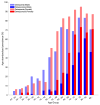Automated Opportunistic Osteoporosis Screening Using Low-Dose Chest CT among Individuals Undergoing Lung Cancer Screening in a Korean Population
- PMID: 39202277
- PMCID: PMC11354205
- DOI: 10.3390/diagnostics14161789
Automated Opportunistic Osteoporosis Screening Using Low-Dose Chest CT among Individuals Undergoing Lung Cancer Screening in a Korean Population
Abstract
Opportunistic osteoporosis screening using deep learning (DL) analysis of low-dose chest CT (LDCT) scans is a potentially promising approach for the early diagnosis of this condition. We explored bone mineral density (BMD) profiles across all adult ages and prevalence of osteoporosis using LDCT with DL in a Korean population. This retrospective study included 1915 participants from two hospitals who underwent LDCT during general health checkups between 2018 and 2021. Trabecular volumetric BMD of L1-2 was automatically calculated using DL and categorized according to the American College of Radiology quantitative computed tomography diagnostic criteria. BMD decreased with age in both men and women. Women had a higher peak BMD in their twenties, but lower BMD than men after 50. Among adults aged 50 and older, the prevalence of osteoporosis and osteopenia was 26.3% and 42.0%, respectively. Osteoporosis prevalence was 18.0% in men and 34.9% in women, increasing with age. Compared to previous data obtained using dual-energy X-ray absorptiometry, the prevalence of osteoporosis, particularly in men, was more than double. The automated opportunistic BMD measurements using LDCT can effectively predict osteoporosis for opportunistic screening and identify high-risk patients. Patients undergoing lung cancer screening may especially profit from this procedure requiring no additional imaging or radiation exposure.
Keywords: bone mineral density; computed tomography; deep learning; opportunistic screening; osteoporosis; prevalence.
Conflict of interest statement
Author Jemyoung Lee was employed by the company ClariPi Inc. The remaining authors declare that the research was conducted in the absence of any.
Figures




Similar articles
-
Opportunistic Screening Using Low-Dose CT and the Prevalence of Osteoporosis in China: A Nationwide, Multicenter Study.J Bone Miner Res. 2021 Mar;36(3):427-435. doi: 10.1002/jbmr.4187. Epub 2020 Nov 4. J Bone Miner Res. 2021. PMID: 33145809 Free PMC article.
-
Opportunistic use of chest low-dose computed tomography (LDCT) imaging for low bone mineral density and osteoporosis screening: cutoff thresholds for the attenuation values of the lower thoracic and upper lumbar vertebrae.Quant Imaging Med Surg. 2024 Jul 1;14(7):4792-4803. doi: 10.21037/qims-24-59. Epub 2024 Jun 24. Quant Imaging Med Surg. 2024. PMID: 39022254 Free PMC article.
-
Automatic opportunistic osteoporosis screening using low-dose chest computed tomography scans obtained for lung cancer screening.Eur Radiol. 2020 Jul;30(7):4107-4116. doi: 10.1007/s00330-020-06679-y. Epub 2020 Feb 19. Eur Radiol. 2020. PMID: 32072260 Free PMC article.
-
Biomechanical Computed Tomography analysis (BCT) for clinical assessment of osteoporosis.Osteoporos Int. 2020 Jun;31(6):1025-1048. doi: 10.1007/s00198-020-05384-2. Epub 2020 Apr 26. Osteoporos Int. 2020. PMID: 32335687 Free PMC article. Review.
-
Quantitative computed tomography and opportunistic bone density screening by dual use of computed tomography scans.J Orthop Translat. 2015 Sep 15;3(4):178-184. doi: 10.1016/j.jot.2015.08.006. eCollection 2015 Oct. J Orthop Translat. 2015. PMID: 30035056 Free PMC article. Review.
References
Grants and funding
LinkOut - more resources
Full Text Sources

